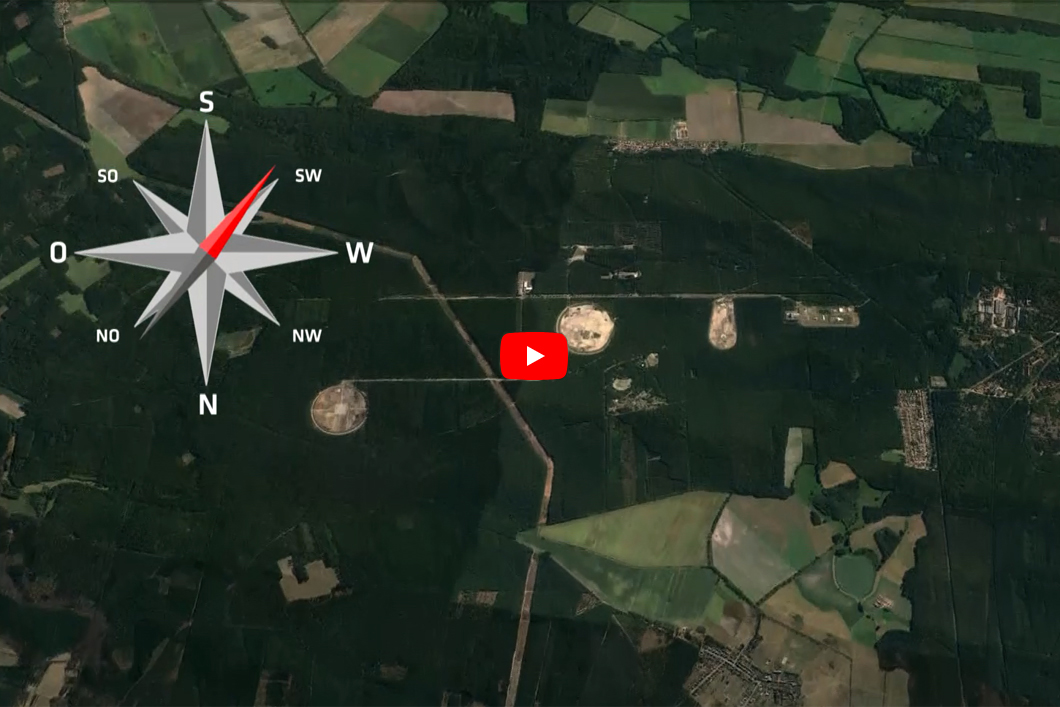
Aerail view of the Test Site for Technical Safety
Source: BAM
If laboratory tests or model calculations are not sufficient to quantify the risks of hazardous substances, large-scale tests need to be carried out on a scale of 1:1. The BAM has been operating a Test Site for Technical Safety (Testgelände Technische Sicherheit - TTS) on an area measuring 12 km2 in Horstwalde in Brandenburg for this purpose since the beginning of the 1990s. True-to-scale experiments are also necessary if, for example, the BAM carries out work in its capacity as a senior federal authority in the field of hazardous substances legislation and explosives law.
The site accommodates two fire test facilities, a designated area for the investigation of fire and explosion hazards, two bunkers with a large number of blast test facilities, such as a firewall system, sealed demolition chamber, and drop impact test facility. The site also includes a unique scenario-based test centre for the qualification, characterisation and validation of UAS-based measurement methods (BAM TUAS).
BAM is currently pushing ahead with the construction of a test centre for modern hydrogen technologies on its test site. This includes a digitally networked research filling station for hydrogen. A test platform for hydrogen and hydrogen-natural gas pipelines is already under construction. Also planned are a high-pressure test stand up to 1000 bar, a test field for liquid hydrogen and a test hall for hydrogen storage.
The focus of the work on the test site is always on improving safety for people, property and the environment. The examples below illustrate the variety of the work we do in Horstwalde:
- Tests for the safety of modern hydrogen technology
- Tests of energy storage devices, especially lithium-ion batteries
- Tests on fireworks
- Tests on airbags and emergency signals for sea rescue
- Research into safety measures for the use of alternative fuels like natural gas, for example, in road traffic
- Tests on containers to check their strength on impact following an accident, for example, in order to prevent the escape of substances harmful to health and hazardous to the environment
- Non-destructive tests on structures
- In the context of market approval: tests on the effectiveness of wood preservatives (protection from weather conditions and harmful organisms)
- Services and cooperations for the qualification, characterisation and validation of UAS-based measurement methods are carried out with the following exemplary scenarios: gas leak from the ground, leak in a gas-carrying pipeline or a pressure vessel, optical building inspection and object measurement.
Vehicle test track
BAM's test site for technical safety is also home to a listed vehicle test track with 25 modules.
These include
- incline tracks (10 tracks with inclines from 5 % to 65 %)
- concrete hilltop and swamp passage
- trial course, off-road track and tree trunk bridge
- sand and mud tracks as well as sand and gravel beds
- torsion tracks, inclined tracks and ditch crossing
- loose sand and scree tracks as well as firm scree slopes
- climbing steps, steep sand slopes and rough tracks
- water passage and concrete basin
The vehicle test track is integrated by BAM into safety-relevant co-operations and research projects. Its primary purpose is to be used by organisations and authorities in the public interest for education, training and testing purposes. Preferred users include civil defence and disaster control forces, the fire service, the police, the German Armed Forces and other rescue organisations. The aim is to promote and strengthen public safety.
In addition, depending on availability, the facility can also be used by companies and other organisations as long as there are compelling reasons or activities that are compatible with the requirements of the Brandenburg Forest Act and the monument protection regulations. Non-authorised users must provide proof of suitable insurance that fully covers all risks associated with the use of the facility prior to use.
Enquiries
For any questions regarding use, logistics or contractual matters, please contact: verkehrsversuchsanlage@bam.de.


